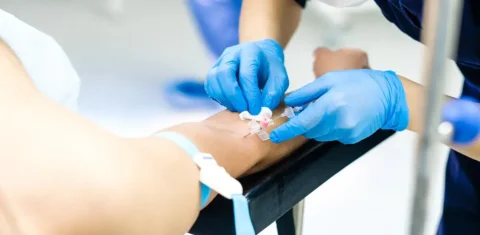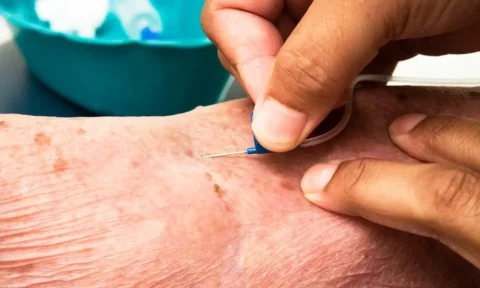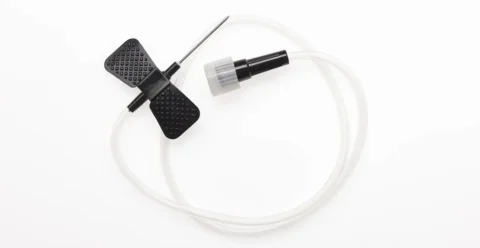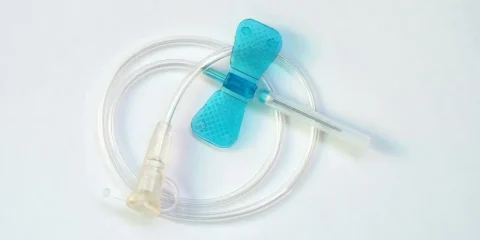Non-invasive prenatal testing, or NIPT, is a new test for pregnant women. It tests for Down Syndrome, also known as Trisomy 21, and other chromosomal abnormalities. A butterfly needle is a thin needle that’s inserted under the skin to draw blood which will be processed and analyzed.
So why is the butterfly needle not a good choice for NIPT? The butterfly needle is not the needle of choice when it comes to NIPT because the needle is too small and narrow that can destroy healthy blood cells and in turn return false results. It can also cause vein damage when a certain amount of blood needs to be taken.
How Are Butterfly Needles Used For Noninvasive Prenatal Testing?
A butterfly needle is inserted into the skin, and then it’s moved back and forth to draw the blood. The needle is then removed from the skin. When used for noninvasive prenatal testing (NIPT), a small sample of blood is taken from your arm or palm using one of these needles. The sample contains DNA from both you and your baby, which can be analyzed for chromosome abnormalities like Down syndrome or trisomy 18.
What Is Non-Invasive Prenatal Testing?
Non-invasive prenatal testing NIPT uses DNA from the mother’s blood to screen for Down syndrome and other chromosomal abnormalities. It’s a non-invasive test, which means it doesn’t involve inserting anything into the uterus. The test is also called cell-free fetal DNA testing because it analyzes fetal DNA that circulates in your bloodstream during pregnancy.
Fetal cells may be found in your blood as early as 7 weeks after conception, but they’re especially plentiful between 10 and 14 weeks of gestation where at this stage of pregnancy, about one in every 200 circulating maternal white blood cells contains a copy of your baby’s genome.
NIPT tests can analyze these tiny fragments to determine whether certain genetic markers are present or absent. The results may indicate whether you have an increased risk of having a child with one or more genetic disorders such as Down syndrome, Edwards syndrome, Patau syndrome), and cystic fibrosis, among others.
It’s important to remember that NIPT is still considered a screening test and not a diagnostic one. This means that it can only tell you if you might be at higher risk for having a child with one of these conditions. It won’t give you a definite answer about whether there’s actually something wrong with your baby.
Are Non-Invasive Prenatal Testing Accurate?
Non-invasive prenatal testing (NIPT) has been shown to be as accurate as standard prenatal screening, though it does not replace traditional diagnostic methods. NIPT is not 100% accurate and cannot detect all chromosomal abnormalities such as trisomies 13, 18 and 21. There are also certain conditions that may pose a risk to the pregnancy if left untreated or undetected for too long after birth.
Are Butterfly Needles Recommended to Use For NIPT?
Butterfly needles are not recommended for non-invasive prenatal testing. The sharp ends of a butterfly needle can cause improper blood collection and redrawing of samples. Butterfly needles can also cause vessel damage, which leads to hemolysis or blood clotting in the vein.
The usage of straight gauge needles is recommended when it comes to NIPT. They are safer than butterfly needles as they do not puncture the vein causing hemolysis or blood clotting in the vein. They are also easier to handle as compared to other types of needle due to their size and curved shape.
Reasons Why Butterfly Needles Are Bad for NIPT
When it comes to NIPT, the butterfly needle isn’t typically recommended to be used for the following reasons:
1) Redrawing of Blood Testing
Redrawing means having another sample drawn after results are received so that new information can be obtained on whether or not something has changed over time. If something has changed, it might affect how doctors interpret your screening results because your results are based on the previous interpretation.
But do note that redrawing isn’t always necessary as sometimes enough information will already be available with just one draw since most labs will perform both an initial screening test as well as confirmatory testing.
2) Not Convenient for Blood Collection
The butterfly needle is not convenient for blood collection for all situations. Needles are not easy to use, handle and store. They can be difficult to dispose of as well. The butterfly needle for NIPT is performed by taking a small amount of blood from the mother’s arm in order to test fetal DNA for genetic abnormalities such as Down syndrome.
The main reason why people choose butterfly needles over other sources of NIPT like ultrasound or amniocentesis tests is because they’re less invasive than traditional methods. Although butterfly needles seem less complicated and invasive, they can cause serious complications. For example, infection or internal bleeding of the veins can happen which poses a problem even though they don’t directly puncture any organs within your body.
3) May Cause Vein Damage
The butterfly needle may cause pain, bruising, swelling and infection of the vein. It can also cause phlebitis, fiber thrombosis or hematoma. In some cases the butterfly needle can cause a sudden drop in blood pressure causing fainting sensations.
4) Aspiration of Blood Sample
In some cases, the doctor will instruct you to have a needle inserted into your arm and then draw out a small amount of blood. This is called aspiration, and it’s how NIPT is performed. Aspiration can be done with a butterfly needle as well but there are also other types of needles that may be used instead such as: straight gauge needles or microcannulas.
Each type has its own advantages and disadvantages so you should discuss these with your healthcare provider before deciding which one works best for you. The main disadvantage with butterfly needles is that it’s too small and narrow for certain procedures. For NIPT, butterfly needles may damage your blood in the process which ends in inaccurate results.
5) Leads to Hemolysis
With the butterfly needle being so small, it can cause discomfort for the patient. It also causes hemolysis, or the destruction of red blood cells. When this happens, you may end up with anemia. You could even experience jaundice (yellowing of your skin), because your body has trouble breaking down old red blood cells.
In addition to these symptoms, intravascular hemolysis can happen when you get a butterfly needle inserted into you. This is when your current red blood cells burst in your bloodstream. If this is the case, you’ll likely feel dizzy and short on breath as well as some abdominal pain along with nausea or vomiting.
Recommended by Phlebotomists
If you’re considering having an NIPT done, you should consult with your health practitioner what type of needle you are using. Depending on your doctor, the needle that can be used can differ. Here are some common points about the needles for your NIPT:
- Needle gauge should be 22-24G.
- Needle length should be 3 inches.
- A straight gauge needle is best for obtaining venous samples because the tip remains in contact with only one side of the vein at all times. This prevents irritation around veins which could potentially lead to bruising or other damage if left untreated
Proper Needles for NIPT Use
The proper needle for NIPT is the straight gauge needle. These are used to insert the sample into the device, and are not intended for withdrawals. If you have been offered a butterfly needle for your NIPT test, do not be afraid to ask for another option.
The best time to use a butterfly needle is when there is no other option available. This is usually only in cases where ultrasound has failed and your doctor feels that it may be too risky to use vaginal ultrasound due to fetal health concerns or abnormalities on screen. It’s important that you are aware of your choices when it comes to your medical procedures.
Straight Gauge Needles Should Be Used for NIPT
Straight gauge needles should be used for NIPT. These can be either 21G or 22G, although the former is preferred. Additionally, the needle should be at least 1 inch in length and must have a diameter of 3.2 mm, which is adequate for blood sample collection for NIPT.
Get Quality Hypodermic Needles and Other Medical Tools From FACE Med Store
The butterfly needle is the common name for a syringe set with short tubing. This form of intravenous access system is most often used on small children and babies. When it comes to NIPT, the butterfly needle is not typically recommended. A straight needle is usually preferred for this procedure to ensure safety and accuracy.
FACE Med Store supplies medical tools to cosmetic and wellness practices such as butterfly needles. Our competitively-priced products give our partners the advantage of providing their customers with a comfortable experience. Discover the different products and services we offer and make sure to contact and check us out today to discover the different needles and services we offer.






